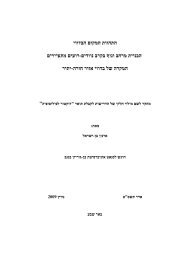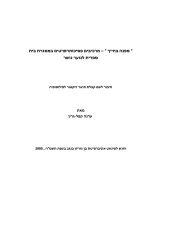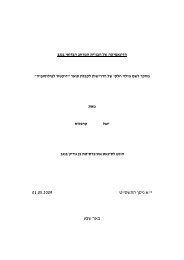Ben-Gurion University of the Negev Jacob Blaustein Institutes for ...
Ben-Gurion University of the Negev Jacob Blaustein Institutes for ...
Ben-Gurion University of the Negev Jacob Blaustein Institutes for ...
Create successful ePaper yourself
Turn your PDF publications into a flip-book with our unique Google optimized e-Paper software.
10<br />
summer it may have from to 2 to 5 months without having any significant precipitation<br />
(Beck et al. 2006).<br />
Temperatures during winter only occasionally reach freezing and snow only rarely<br />
occurs at sea level. In <strong>the</strong> winter, <strong>the</strong> temperatures range from mild to very warm,<br />
depending on distance from <strong>the</strong> sea and elevation. Even in <strong>the</strong> warmest locations,<br />
however, temperatures usually don't reach <strong>the</strong> highest readings found in adjacent desert<br />
regions due to cooling effect <strong>of</strong> water bodies, although strong winds (Scirocco 4 ) from<br />
North African desert regions can sometimes boost summer temperatures. Inland<br />
locations sheltered from or distant from sea breezes can experience severe heat during<br />
<strong>the</strong> summer (Beck et al. 2006).<br />
2.3 Rainfall trend in Sicily: Spatial Distribution<br />
Historical series were analyzed using spatial analysis techniques in a GIS environment<br />
(Piccione et al., 2008). The application was conducted using monthly data, recorded or<br />
reconstructed from 247 rain gauge stations during <strong>the</strong> period 1931–1990.<br />
Average annual rainfall indexes have been calculated according to <strong>the</strong> Medalus<br />
methodology (European Commission, 1999) in two different periods (1931-1960 and<br />
1961-1990). Figures 3 shows in dark green <strong>the</strong> spatial distribution <strong>of</strong> year precipitations<br />
larger than 650 mm in <strong>the</strong> period 1931-1960 and figure 4 shows <strong>the</strong> same patterns in <strong>the</strong><br />
period 1961-90. The percentage <strong>of</strong> regional surface areas with precipitations larger than<br />
650 mm per year decreased from 60% to 34%. Moreover, it can be seen that a great<br />
number <strong>of</strong> stations with a statistically significant negative trend are located in <strong>the</strong><br />
western and south-western part <strong>of</strong> <strong>the</strong> island (Piccione et al., 2008) corresponding to <strong>the</strong><br />
study area.<br />
4 Sirocco, scirocco, jugo or, rarely, siroc is a Mediterranean wind that comes from <strong>the</strong> Sahara and reaches<br />
hurricane speeds in North Africa and Sou<strong>the</strong>rn Europe. It is known in North Africa by <strong>the</strong> arabic word<br />
qibli (i.e. "coming from <strong>the</strong> qibla".)
















